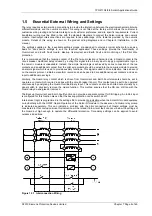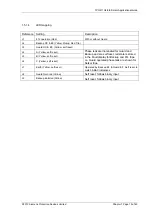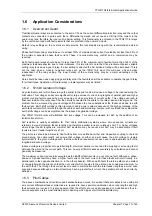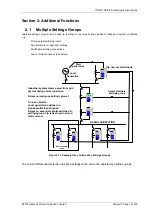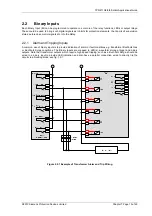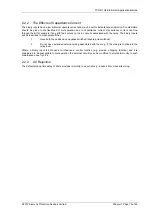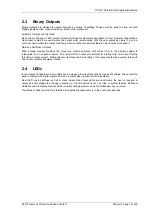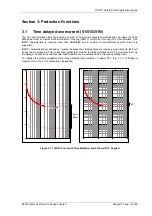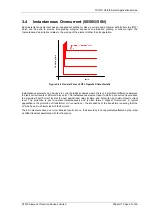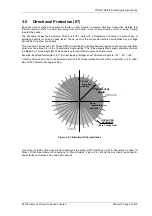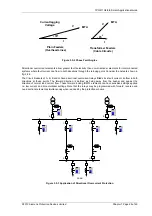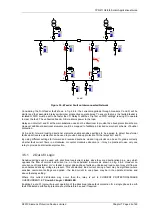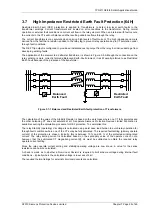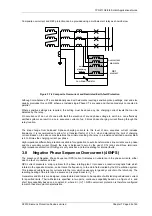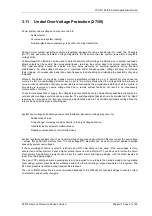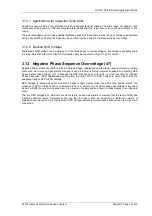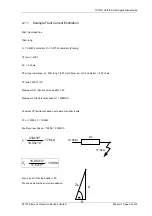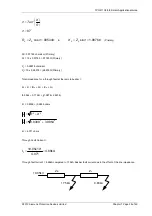
7PG2113/4/5/6 Solkor Applications Guide
3.2
Voltage dependent overcurrent (51V)
Reduced voltage can indicate a fault on the system, it can be used to make the 51 elements more sensitive.
Typically Voltage Dependent Over-current (VDO) is applied to:
Transformer Incomers: Where the impedance of the transformer limits fault current the measured voltage level
can be used to discriminate between load and fault current.
Long lines: Where the impedance of the line limits fault current the measured voltage level can be used to
discriminate between load and fault current.
Generator circuits: When a Generator is subjected to a short circuit close to its terminals the short-circuit current
follows a complex profile. After the initial "sub-transient" value, generally in the order of 7 to 10 times full load
current, it falls rapidly (around 10 to 20ms) to the "transient" value. This is still about 5 to 7 times full load and
would be sufficient to operate the protection's over-current elements. However the effect on armature reactance of
the highly inductive short-circuit current is to increase significantly the internal impedance to the synchronous
reactance value. If the Automatic Voltage Regulation (AVR) system does not respond to increase the excitation,
the fault current will decay over the next few seconds to a value below the full load current. This is termed the
steady state fault current, determined by the Generator's synchronous reactance (and pre-fault excitation). It will
be insufficient to operate the protection's over-current elements and the fault will not be detected. Even if AVR is
active, problems may still be encountered. The AVR will have a declared minimum sustained fault current and this
must be above the protection over-current settings. Close-in short circuit faults may also cause the AVR to reach
its safety limits for supplying maximum excitation boost, in the order of several seconds, and this will result in AVR
internal protection devices such as diode fuses to start operating. The generator excitation will then collapse, and
the situation will be the same as when no AVR was present. The fault may again not be detected.
Current grading remains important since a significant voltage reduction may be seen for faults on other parts of
the system. An inverse time operating characteristic must therefore be used.
The VDO Level - the voltage setting below which the more sensitive operating curve applies - must be set low
enough to discriminate between short-circuits and temporary voltage dips due to overloads. However, it must also
be high enough to cover a range of voltage drops for different circuit configurations, from around 0.6Vn to almost
zero. Typically it will be set in the range 0.6 to 0.8Vn.
3.3
Cold Load Settings (51c)
Once a Circuit-Breaker has been open for a period of time, higher than normal levels of load current may flow
following CB re-closure e.g. heating or refrigeration plant. The size and duration of this current is dependent upon
the type of load and the time that the CB is open.
The feature allows the relay to use alternative Shaped Overcurrent (51c) settings when a Cold Load condition is
identified. The cold load current and time multiplier settings will normally be set higher than those of the normal
overcurrent settings.
The relay will revert to its usual settings (51-n) after elapse of the cold load period. This is determined either by a
user set delay, or by the current in all 3-phases falling below a set level (usually related to normal load levels) for
a user set period.
©2010 Siemens Protection Devices Limited
Chapter 7 Page 22 of 49

